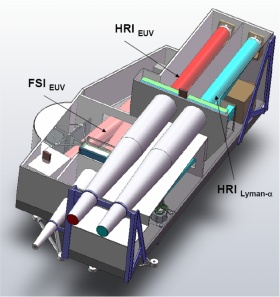
|
EUI: Solar-Orbiter Extreme-Ultraviolet Imager
|
 |

|
EUI: Solar-Orbiter Extreme-Ultraviolet Imager
|
 |
The Extreme-Ultraviolet Imager (EUI) is a suite of remote-sensing telescopes which will image at high resolution the structures in the solar atmosphere from the chromosphere to the corona. The instrument package contains two high-resolution telescopes and a full-Sun imager. Thus EUI will observe and analyse the global morphology and local dynamics of the solar atmosphere, in particular at the base of the corona. The full-Sun imager will show the gross structure of the whole Sun at coronal temperatures, while the high-resolution telescopes will show in selected wavelength bands the fine structures that become visible in the close-up views of the Sun by Solar Orbiter during its perihelion phase of the orbit.
| Science objectives |
|
| The Instrument |
|
|
MPS contribution |
|
| The Team |
|
| Related links |
|
| EUI Team-Page for team-internal usage only |
|
| Solar Orbiter publications by MPS members |
The scientific goals of the EUI instrument suite is to provide high-resolution extreme-ultraviolet images of the corona, in order to reveal the fine-scale structure of coronal features, and to take full-disk images of the Sun, at any part of the orbit in order to reveal the global structure and irradiance of the Sun, and of its polar regions. Thus EUI will provide the necessary context images, in particular for SPICE and METIS. Such images are required to establish the links between in-situ and remote-sensing observations, i.e. the solar surface and the heliosphere. EUI will be capable of providing image sequences at high cadence so that fast events can be followed in time while the other remote-sensing instruments on Solar Orbiter also observe the same scene.
 The EUI instrument suite is composed of two high resolution imagers (HRI), one at Lyman-α and one dual-band in the extreme UV, alternatively at 174 and 335 Å, respectively named “HRILy-α” and “HRIEUV”, and one dual-band full-sun imager (FSI) working alternatively at the 174 and 304 Å EUV passbands, named “FSI174/304”. In all channels, the image is produced by a two-mirror telescope, working in near normal incidence. The EUV reflectivity of the optical surfaces is obtained with specific EUV multilayer coatings, providing the spectral selection of the units.
The spectral selection is complemented with filters rejecting the visible and IR radiation. Only the UV photons can reach the detectors where they are converted into an electrical signal. For the Lyman-α HRI a special “solar-blind” camera is being developed.
The EUI instrument suite is composed of two high resolution imagers (HRI), one at Lyman-α and one dual-band in the extreme UV, alternatively at 174 and 335 Å, respectively named “HRILy-α” and “HRIEUV”, and one dual-band full-sun imager (FSI) working alternatively at the 174 and 304 Å EUV passbands, named “FSI174/304”. In all channels, the image is produced by a two-mirror telescope, working in near normal incidence. The EUV reflectivity of the optical surfaces is obtained with specific EUV multilayer coatings, providing the spectral selection of the units.
The spectral selection is complemented with filters rejecting the visible and IR radiation. Only the UV photons can reach the detectors where they are converted into an electrical signal. For the Lyman-α HRI a special “solar-blind” camera is being developed.
Figure 1: The EUI instrument suite
MPS takes a leading role in the development of the instruments of EUI and has responsibility for building one HRI telescope for the hydrogen Lyman-α line at 121.6 nm.
Solar Orbiter Detector Development: MPS is making efforts to develop new detectors for future solar missions, in particular for the extreme and vacuum-ultraviolet part of the spectrum. The wavelength region of solar coronal emission extends from the extreme ultraviolet (EUV) to the near ultraviolet (NUV), a spectral range that is technologically difficult as far as the optics and sensors are concerned. MPS participates in the development of UV cameras using micro-channelplate intensifiers and, also, imaging devices using wide-band-gap materials. The institute has the expertise and facilities to characterise new detector devices in the extreme ultraviolet and the visible part of the electro-magnetic spectrum, and to build electronic readout systems for space flight.
| Co-Principal Investigator | Dr. Udo Schühle |
|---|---|
| Co-Investigators | Prof. Jörg Büchner Dr. Werner Curdt Prof. Dr. Eckart Marsch Prof. Dr. Sami Solanki Dr. Luca Teriaca |
| Project Manager | Dr. Michael Kahle |
| Product Assurance | Reinhard Mueller |
| Optical Engineering | Bianca Grauf |
| Mechanical Engineering | Bernd Chares Jan Heinrichs |
| Electronic Engineering | Klaus Heerlein Rainer Enge Michael Sperling Stephan Werner Juanjo Piqueras |
| Software development | Dr. Iancu Pardowitz Martin Kolleck |
| Solar-Orbiter at ESA |
|
| Solar-Orbiter PHI Polarimetric and Helioseismic Imager |
|
| Solar-Orbiter SPICE Spectral Imaging of the Coronal Environment |
|
| Solar-Orbiter METIS/ICOR Multi Element Telescope for Imaging and Spectroscopy |
| © 2009, Max-Planck-Institut für Sonnensystemforschung, Lindau |
U. Schühle 24-03-2010 |